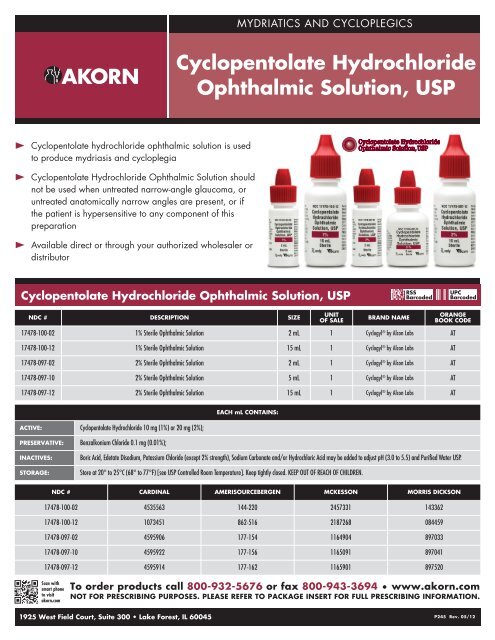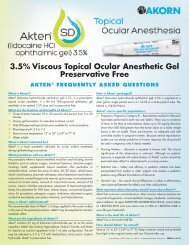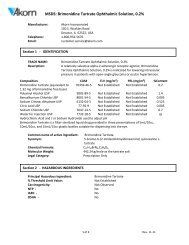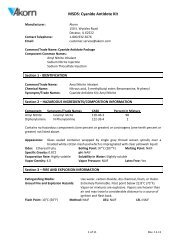Layout 1
Layout 1
Layout 1
Create successful ePaper yourself
Turn your PDF publications into a flip-book with our unique Google optimized e-Paper software.
Cyclopentolate hydrochloride ophthalmic solution is used<br />
to produce mydriasis and cycloplegia<br />
Cyclopentolate Hydrochloride Ophthalmic Solution should<br />
not be used when untreated narrow-angle glaucoma, or<br />
untreated anatomically narrow angles are present, or if<br />
the patient is hypersensitive to any component of this<br />
preparation<br />
Available direct or through your authorized wholesaler or<br />
distributor<br />
Cyclopentolate Hydrochloride<br />
Ophthalmic Solution, USP<br />
Cyclopentolate Hydrochloride Ophthalmic Solution, USP<br />
NDC # DESCRIPTION SIZE<br />
UNIT<br />
OF SALE<br />
BRAND NAME<br />
NDC # CARDINAL AMERISOURCEBERGEN MCKESSON MORRIS DICKSON<br />
17478-100-02 4535563 144-220 2457331 143362<br />
17478-100-12 1073451 862-516 2187268 084459<br />
17478-097-02 4595906 177-154 1164904 897033<br />
17478-097-10 4595922 177-156 1165091 897041<br />
17478-097-12 4595914 177-162 1165901 897520<br />
ORANGE<br />
BOOK CODE<br />
17478-100-02 1% Sterile Ophthalmic Solution 2 mL 1 Cyclogyl ® by Alcon Labs AT<br />
17478-100-12 1% Sterile Ophthalmic Solution 15 mL 1 Cyclogyl ® by Alcon Labs AT<br />
17478-097-02 2% Sterile Ophthalmic Solution 2 mL 1 Cyclogyl ® by Alcon Labs AT<br />
17478-097-10 2% Sterile Ophthalmic Solution 5 mL 1 Cyclogyl ® by Alcon Labs AT<br />
17478-097-12 2% Sterile Ophthalmic Solution 15 mL 1 Cyclogyl ® by Alcon Labs AT<br />
ACTIVE: Cyclopentolate Hydrochloride 10 mg (1%) or 20 mg (2%);<br />
PRESERVATIVE: Benzalkonium Chloride 0.1 mg (0.01%);<br />
MYDRIATICS AND CYCLOPLEGICS<br />
EACH mL CONTAINS:<br />
INACTIVES: Boric Acid, Edetate Disodium, Potassium Chloride (except 2% strength), Sodium Carbonate and/or Hydrochloric Acid may be added to adjust pH (3.0 to 5.5) and Purified Water USP.<br />
STORAGE: Store at 20° to 25°C (68° to 77°F) [see USP Controlled Room Temperature]. Keep tightly closed. KEEP OUT OF REACH OF CHILDREN.<br />
Scan with<br />
smart phone<br />
to visit<br />
akorn.com<br />
To order products call 800-932-5676 or fax 800-943-3694 • www.akorn.com<br />
NOT FOR PRESCRIBING PURPOSES. PLEASE REFER TO PACKAGE INSERT FOR FULL PRESCRIBING INFORMATION.<br />
1925 West Field Court, Suite 300 • Lake Forest, IL 60045<br />
P245 Rev. 05/12
Cyclopentolate<br />
Hydrochloride Ophthalmic<br />
Solution, USP -Sterile<br />
DESCRIPTION: Cyclopentolate Hydrochloride Ophthalmic Solution is<br />
an anticholinergic prepared as a sterile, borate buffered solution for top-<br />
ical ocular use. It is supplied in two strengths.<br />
Chemical name:<br />
2-(Dimethylamino)ethyl 1-hydroxy-α-<br />
phenylcyclopentaneacetate hydrochloride<br />
MW=327.85 C 17H 25NO 3 • HCl<br />
The active ingredient is represented by the structural formula:<br />
Cyclopentolate Hydrochloride Ophthalmic Solution USP, 1% & 2%<br />
Each mL contains: Active: Cyclopentolate Hydrochloride 10 mg (1%)<br />
or 20 mg (2%).<br />
Inactives: Boric Acid, Edetate Disodium, Potassium Chloride (except<br />
2% strength), Sodium Carbonate and/or Hydrochloric Acid may be<br />
added to adjust pH (3.0 to 5.5) and Purified Water USP.<br />
Preservative: Benzalkonium Chloride 0.1 mg (0.01%).<br />
CLINICAL PHARMACOLOGY: This anticholinergic preparation blocks<br />
the responses of the sphincter muscle of the iris and the accommoda-<br />
tive muscle of the ciliary body to cholinergic stimulation, producing<br />
pupillary dilation (mydriasis) and paralysis of accommodation (cyclo-<br />
plegia). It acts rapidly, but has a shorter duration than atropine. Maxi-<br />
mal cycloplegia occurs within 25 to 75 minutes after instillation.<br />
Complete recovery of accommodation usually takes 6 to 24 hours.<br />
Complete recovery from mydriasis in some individuals may require sev-<br />
eral days. Heavily pigmented irides may require more doses than lightly<br />
pigmented irides.<br />
INDICATIONS AND USAGE: Cyclopentolate hydrochloride ophthalmic<br />
solution is used to produce mydriasis and cycloplegia.<br />
CONTRAINDICATIONS: Cyclopentolate Hydrochloride Ophthalmic So-<br />
lution should not be used when untreated narrow-angle glaucoma, or<br />
untreated anatomically narrow angles are present, or if the patient is<br />
hypersensitive to any component of this preparation.<br />
WARNINGS: For topical ophthalmic use only. Not for injection. This<br />
preparation may cause CNS disturbances. This is especially true in<br />
younger age groups, but may occur at any age, especially with the<br />
stronger solutions. Infants are especially prone to CNS and cardiopul-<br />
monary side effects from cyclopentolate. To minimize absorption, use<br />
only 1 drop of 0.5% cyclopentolate hydrochloride ophthalmic solution<br />
per eye, followed by pressure applied over the nasolacrimal sac for two<br />
to three minutes. Observe infants closely for at least 30 minutes.<br />
Mydriatics may produce a transient elevation of intraocular pressure.<br />
PRECAUTIONS: General: The lacrimal sac should be compressed by<br />
digital pressure for two to three minutes after instillation to reduce ex-<br />
cessive systemic absorption. Caution should be observed when consid-<br />
ering use of this medication in the presence of Down’s syndrome and<br />
in those predisposed to angle-closure glaucoma.<br />
Information for Patients: Do not touch dropper tip to any surface, as<br />
this may contaminate the solution. A transient burning sensation may<br />
occur upon instillation. Patients should be advised not to drive or en-<br />
gage in other hazardous activities while pupils are dilated. Patients may<br />
experience sensitivity to light and should protect eyes in bright illumi-<br />
nation during dilation. Parents should be warned not to get this prepa-<br />
ration in their child’s mouth and to wash their own hands and the child’s<br />
hands following administration. Feeding intolerance may follow oph-<br />
thalmic use of this product in infants. It is recommended that feeding<br />
be withheld for four (4) hours after examination.<br />
Drug Interactions: Cyclopentolate may interfere with the ocular anti-<br />
hypertensive action of carbachol, pilocarpine, or ophthalmic<br />
cholinesterase inhibitors.<br />
Carcinogenesis, Mutagenesis, and Impairment of Fertility: Studies<br />
in animals or humans have not been conducted to evaluate the carcino-<br />
genic potential of cyclopentolate.<br />
Pregnancy: Pregnancy Category C. Animal reproduction studies have<br />
not been conducted with cyclopentolate. It is also not known whether<br />
cyclopentolate can cause fetal harm when administered to a pregnant<br />
woman or can affect reproduction capacity. Cyclopentolate should be<br />
administered to a pregnant woman only if clearly needed.<br />
Nursing Mothers: It is not known whether this drug is excreted in<br />
human milk. Because many drugs are excreted in human milk, caution<br />
should be exercised when cyclopentolate hydrochloride is administered<br />
to a nursing woman.<br />
Pediatric Use: Use of cyclopentolate has been associated with psy-<br />
chotic reactions and behavioral disturbances in pediatric patients. In-<br />
creased susceptibility to cyclopentolate has been reported in infants,<br />
young children, and in children with spastic paralysis or brain damage.<br />
These disturbances include ataxia, incoherent speech, restlessness, hal-<br />
lucinations, hyperactivity, seizures, disorientation as to time and place,<br />
and failure to recognize people. Feeding intolerance may follow oph-<br />
thalmic use of this product in infants. It is recommended that feeding<br />
be withheld for four (4) hours after examination. Observe infants closely<br />
for at least 30 minutes (see WARNINGS).<br />
ADVERSE REACTIONS: Ocular: Increased intraocular pressure, burning,<br />
photophobia, blurred vision, irritation, hyperemia, conjunctivitis,<br />
blepharoconjunctivitis, punctate keratitis, synechiae have been reported.<br />
Non-ocular: Use of cyclopentolate has been associated with psychotic<br />
reactions and behavioral disturbances, usually in children, especially<br />
with 2% concentration. These disturbances include ataxia, incoherent<br />
speech, restlessness, hallucinations, hyperactivity, seizures, disorientation<br />
as to time and place, and failure to recognize people. This drug<br />
produces reactions similar to those of other anticholinergic drugs, but<br />
the central nervous system manifestations as noted above are more<br />
common. Other manifestations of anticholinergic drugs are skin rash,<br />
abdominal distention in infants, unusual drowsiness, tachycardia, hyperpyrexia,<br />
vasodilation, urinary retention, diminished gastrointestinal<br />
motility and decreased secretion in salivary and sweat glands, pharynx,<br />
bronchi and nasal passages. Severe manifestations of toxicity include<br />
coma, medullary paralysis and death.<br />
OVERDOSAGE: Excessive dosage may produce behavioral disturbances,<br />
tachycardia, hyperpyrexia, hypertension, elevated intraocular<br />
pressure, vasodilation, urinary retention, diminished gastrointestinal<br />
motility and decreased secretion in salivary and sweat glands, pharynx,<br />
bronchi and nasal passages. Patients exhibiting signs of overdosage<br />
should receive supportive care and monitoring.<br />
DOSAGE AND ADMINISTRATION: Adults: Instill one or two drops of<br />
1% or 2% solution in the eye which may be repeated in five to ten minutes<br />
if necessary. Complete recovery usually occurs in 24 hours. Complete<br />
recovery from mydriasis in some individuals may require several<br />
days. Children: Instill one or two drops of 1% or 2% solution in the eye<br />
which may be repeated five to ten minutes later by a second application<br />
of 1% solution if necessary.<br />
HOW SUPPLIED: Cyclopentolate Hydrochloride Ophthalmic Solution,<br />
USP is a sterile ophthalmic solution supplied in white opaque plastic<br />
dropper bottles as follows:<br />
Cyclopentolate Hydrochloride Ophthalmic Solution USP, 1%<br />
2 mL NDC 17478-100-02<br />
5 mL NDC 17478-100-10<br />
15 mL NDC 17478-100-12<br />
Cyclopentolate Hydrochloride Ophthalmic Solution USP, 2%<br />
2 mL NDC 17478-097-02<br />
5 mL NDC 17478-097-10<br />
15 mL NDC 17478-097-12<br />
DO NOT USE IF IMPRINTED SEAL IS BROKEN OR MISSING.<br />
Storage: Store at 20° to 25°C (68° to 77°F) [see USP Controlled Room<br />
Temperature]. Keep tightly closed.<br />
KEEP OUT OF THE REACH OF CHILDREN.<br />
CC00N Rev. 06/11








